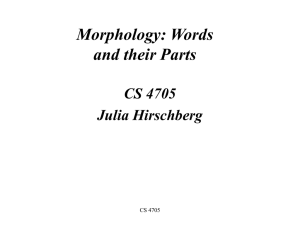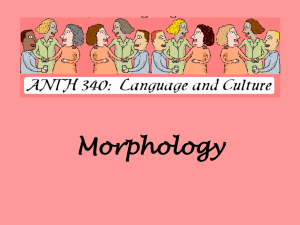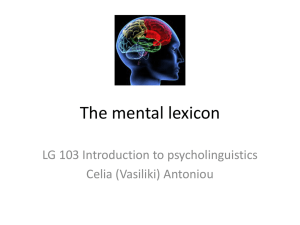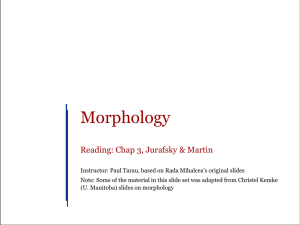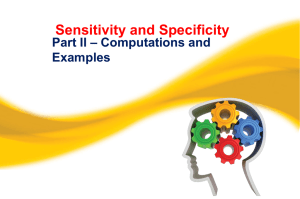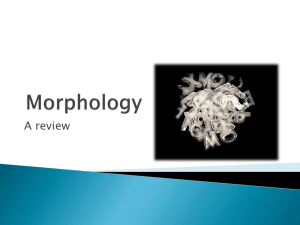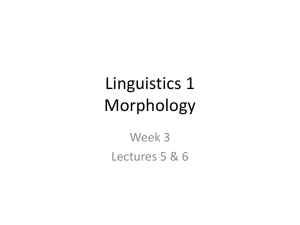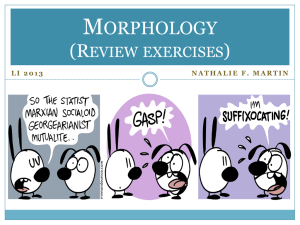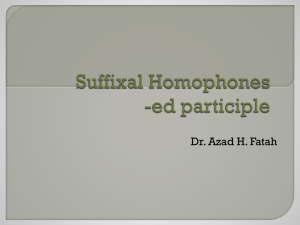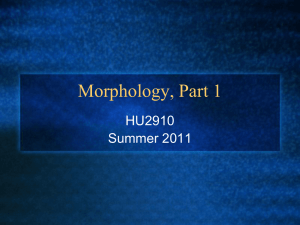lec03-morpohology
advertisement
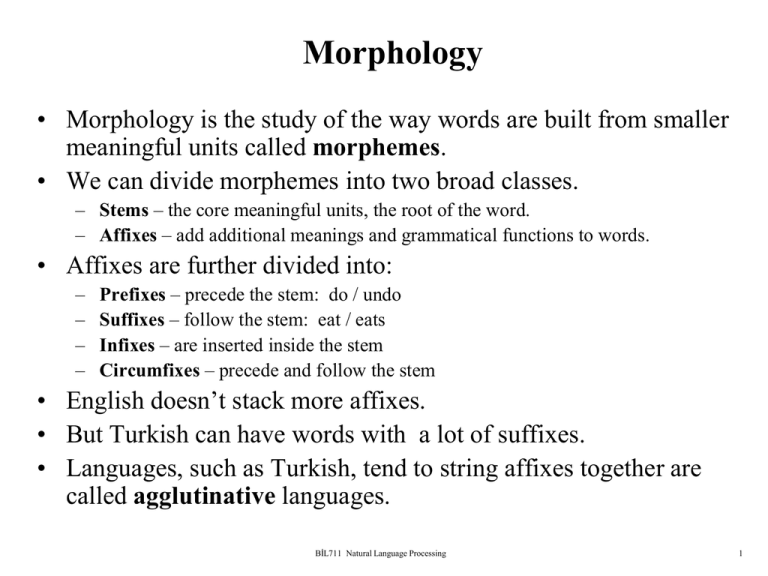
Morphology
• Morphology is the study of the way words are built from smaller
meaningful units called morphemes.
• We can divide morphemes into two broad classes.
– Stems – the core meaningful units, the root of the word.
– Affixes – add additional meanings and grammatical functions to words.
• Affixes are further divided into:
–
–
–
–
Prefixes – precede the stem: do / undo
Suffixes – follow the stem: eat / eats
Infixes – are inserted inside the stem
Circumfixes – precede and follow the stem
• English doesn’t stack more affixes.
• But Turkish can have words with a lot of suffixes.
• Languages, such as Turkish, tend to string affixes together are
called agglutinative languages.
BİL711 Natural Language Processing
1
Surface and Lexical Forms
• The surface level of a word represents the actual spelling
of that word.
– geliyorum eats cats kitabım
• The lexical level of a word represents a simple concatenation
of morphemes making up that word.
–
–
–
–
gel +PROG +1SG
eat +AOR
cat +PLU
kitap +P1SG
• Morphological processors try to find correspondences between
lexical and surface forms of words.
– Morphological recognition – surface to lexical
– Morphological generation – lexical to surface
BİL711 Natural Language Processing
2
Inflectional and Derivational Morphology
• There are two broad classes of morphology:
– Inflectional morphology
– Derivational morphology
• After a combination with an inflectional morpheme,
the meaning and class of the actual stem usually do not change.
– eat / eats
– gel / geliyorum
pencil / pencils
masa / masam
• After a combination with an derivational morpheme, the
meaning and the class of the actual stem usually change.
– compute / computer
– Uygar / uygarlaş
do / undo
kapı / kapıcı
friend / friendly
• The irregular changes may happen with derivational affixes.
BİL711 Natural Language Processing
3
English Inflectional Morphology
• Nouns have simple inflectional morphology.
– plural -- cat / cats
– possessive -- John / John’s
• Verbs have slightly more complex inflectional, but still relatively
simple inflectional morphology.
–
–
–
–
past form -- walk / walked
past participle form -- walk / walked
gerund -- walk / walking
singular third person -- walk / walks
• Verbs can be categorized as:
– main verbs
– modal verbs -- can, will, should
– primary verbs -- be, have, do
• Regular and irregular verbs:
walk / walked -- go / went
BİL711 Natural Language Processing
4
English Derivational Morphology
• Some English derivational affixes
– -ation : transport / transportation
– -er : kill / killer
– -ness : fuzzy / fuzziness
– -al : computation / computational
– -able : break / breakable
– -less : help / helpless
– un : do / undo
– re : try / retry
BİL711 Natural Language Processing
5
Turkish Inflectional Morphology
• Some of inflectional suffixes that Turkish nouns can have:
– singular/plural : masa / masalar
– possessive markers : masam / masan / masası / masamız / masanız / masaları
– case markers :
• ablative : masadan
• accusative : masayı
• dative : masaya
• Some of inflectional suffixes that Turkish verbs can have:
– tense : gel / geldi / geliyor / gelmiş / gelecek
– second tense : geliyordu / gelmişti / gelecekti
– agreement marker : geldim / geldin / geldi / geldik / geldiniz / geldiler
• There are order among inflectional suffixes (morphotactics )
– masalarımdan -- masa +PLU +P1SG +ABL
– geliyordum -- gel +PROG +PAST +1SG
BİL711 Natural Language Processing
6
Turkish Derivational Morphology
• Turkish derivational morphology is very rich. Some of
derivational suffixes in Turkish:
– -cı : kapı / kapıcı
– -laş : uygar / uygarlaş
– -mek : gel / gelmek
– -cik : mini / minicik
– -li : Ankara / Ankaralı
BİL711 Natural Language Processing
7
Morphological Parsing
• Morphological parsing is to find the lexical form of a word
from its surface form.
–
–
–
–
–
–
–
–
–
cats -- cat +N +PLU
cat -- cat +N +SG
goose -- goose +N +SG or goose +V
geese -- goose +N +PLU
gooses -- goose +V +3SG
catch -- catch +V
caught -- catch +V +PAST or catch +V +PP
geliyorum -- gel +V +PROG +1SG
masalardan -- masa +N +PLU +ABL
• There can be more than one lexical level representation
for a given word. (ambiguity)
BİL711 Natural Language Processing
8
Parts of A Morphological Processor
• For a morphological processor, we need at least followings:
• Lexicon : The list of stems and affixes together with basic
information about them such as their main categories (noun, verb,
adjective, …) and their sub-categories (regular noun, irregular
noun, …).
• Morphotactics : The model of morpheme ordering that explains
which classes of morphemes can follow other classes of
morphemes inside a word.
• Orthographic Rules (Spelling Rules) : These spelling rules are
used to model changes that occur in a word (normally when two
morphemes combine).
BİL711 Natural Language Processing
9
Lexicon
• A lexicon is a repository for words (stems).
• They are grouped according to their main categories.
– noun, verb, adjective, adverb, …
• They may be also divided into sub-categories.
– regular-nouns, irregular-singular nouns, irregular-plural nouns, …
• The simplest way to create a morphological parser, put all
possible words (together with its inflections) into a lexicon.
– We do not this because their numbers are huge (theoratically for Turkish,
it is infinite)
BİL711 Natural Language Processing
10
Morphotactics
• Which morphemes can follow which morphemes.
Lexicon:
regular-noun irregular-pl-noun irreg-sg-noun
fox
cat
dog
geese
sheep
mice
goose
sheep
mouse
plural
-s
• Simple English Nominal Inflection (Morphotactic Rules)
reg-noun
0
plural (-s)
1
irreg-sg-noun
2
irreg-pl-noun
BİL711 Natural Language Processing
11
Combine Lexicon and Morphotactics
o
x
f
c
d
a
t
o
g
s
s
h
e
e
e
g
o
o
m
p
s
e
e
o
u
i
e
s
c
This only says yes or no. Does not give lexical representation.
It accepts a wrong word (foxs).
BİL711 Natural Language Processing
12
Two-Level Morphology
• Two-level morphology represents the correspondence between
lexical and surface levels.
• We use a finite-state transducer to find mapping between these
two levels.
• A FST is a two-tape automaton:
– Reads from one tape, and writes to other one.
• For morphological processing, one tape holds lexical
representation, the second one holds the surface form of a word.
Lexical Tape
d
o
g
Surface Tape
d
o
g
+N +PL
s
BİL711 Natural Language Processing
(upper tape)
(lower tape)
13
Formal Definition of FST (Mealey Machine)
• FST is Q x x q0 x F x
• Q : a finite set of N states q0, q1, … qN
• : a finite input alphabet of complex symbols.
–
–
–
–
–
Each complex symbol is a pair of an input and an output symbol i:o
where i is a member of I (an input alphabet),
and o is a member of O (an output alphabet).
I and O may contain empty string.
So, is a subset of IxO.
• q0 : the start state
• F : the set of final states -- F is a subset of Q
• (q,i:o) : transition function
BİL711 Natural Language Processing
14
FST (cont.)
• may not contain all possible pairs from IxO.
• For example:
– I = {a, b, c}
O={a,b,c, є}
– = {a:a, b:b, c:c, a:є, b: є, c: є}
• feasible pairs – In two-level morphology terminology, the pairs
in are called as feasible pairs.
• default pair – Instead of a:a we can use a single character for this
default pair.
• FSAs are isomorphic to regular languages, and FSTs are
isomorphic to regular relations (pair of strings of regular
languages).
BİL711 Natural Language Processing
15
FST Properties
• FSTs are closed under: union, inversion, and composition.
• union : The union of two regular relations is also a regular
relation.
• inversion : The inversion of a FST simply switches the input and
output labels.
– This means that the same FST can be used for both directions of a morphological
processor.
• composition : If T1 is a FST from I1 to O1 and T2 is a FST from
O1 to O2, then composition of T1 and T2 (T1oT2) maps from I1 to
O2.
• We use these properties of FSTs in the creation of the FST for a
morphological processor.
BİL711 Natural Language Processing
16
A FST for Simple English Nominals
+N: є
reg-noun
irreg-sg-noun
+N: є
irreg-pl-noun
+S:#
+PL:^s#
+SG:#
+PL:#
+N: є
BİL711 Natural Language Processing
17
FST for stems
• A FST for stems which maps roots to their root-class
reg-noun
irreg-pl-noun
irreg-sg-noun
fox
cat
dog
g o:e o:e se
sheep
m o:i u:є s:c e
goose
sheep
mouse
• fox stands for f:f o:o x:x
• When these two transducers are composed, we have a FST which
maps lexical forms to intermediate forms of words for simple
English noun inflections.
• Next thing that we should handle is to design the FSTs for
orthographic rules, and combine all these transducers.
BİL711 Natural Language Processing
18
Multi-Level Multi-Tape Machines
• A frequently use FST idiom, called cascade, is to have the output
of one FST read in as the input to a subsequent machine.
• So, to handle spelling we use three tapes:
– lexical, intermediate and surface
• We need one transducer to work between the lexical and
intermediate levels, and a second (a bunch of FSTs) to work
between intermediate and surface levels to patch up the spelling.
lexical
d
o
g
+N +PL
intermediate
d
o
g
^
surface
d
o
g
s
BİL711 Natural Language Processing
s #
19
Lexical to Intermediate FST
BİL711 Natural Language Processing
20
Orthographic Rules
• We need FSTs to map intermediate level to surface level.
• For each spelling rule we will have a FST, and these FSTs run
parallel.
• Some of English Spelling Rules:
–
–
–
–
–
consonant doubling -- 1-letter consonant doubled before ing/ed -- beg/begging
E deletion - Silent e dropped before ing and ed -- make/making
E insertion -- e added after s, z, x, ch, sh before s -- watch/watches
Y replacement -- y changes to ie before s, and to i before ed -- try/tries
K insertion -- verbs ending with vowel+c we add k -- panic/panicked
• We represent these rules using two-level morphology rules:
– a => b / c __ d
rewrite a as b when it occurs between c and d.
BİL711 Natural Language Processing
21
FST for E-Insertion Rule
E-insertion rule: є => e / {x,s,z}^ __ s#
^ (morpheme boundary) means ^: є
BİL711 Natural Language Processing
22
Generating or Parsing with FST Lexicon and
Rules
BİL711 Natural Language Processing
23
Accepting Foxes
BİL711 Natural Language Processing
24
Intersection
• We can intersect all rule FSTs to create a single FST.
• Intersection algorithm just takes the Cartesian product of states.
– For each state qi of the first machine and qj of the second
machine, we create a new state qij
– For input symbol a, if the first machine would transition to
state qn and the second machine would transition to qm the
new machine would transition to qnm.
BİL711 Natural Language Processing
25
Composition
• Cascade can turn out to be somewhat pain.
– it is hard to manage all tapes
– it fails to take advantage of restricting power of the machines
• So, it is better to compile the cascade into a single large machine.
• Create a new state (x,y) for every pair of states x є Q1 and y є Q2.
The transition function of composition will be defined as follows:
δ((x,y),i:o) = (v,z) if
there exists c such that δ1(x,i:c) = v and δ2(y,c:o) = z
BİL711 Natural Language Processing
26
Intersect Rule FSTs
lexical tape
LEXICON-FST
intermediate tape
FST1 … FSTn
=> FSTR = FST1 ^ … ^ FSTn
surface tape
BİL711 Natural Language Processing
27
Compose Lexicon and Rule FSTs
lexical tape
lexical tape
LEXICON-FST
intermediate tape
=> LEXICON-FST o FSTR
FSTR = FST1 ^ … ^ FSTn
surface level
surface tape
BİL711 Natural Language Processing
28
Porter Stemming
• Some applications (some informational retrieval applications) do
not the whole morphological processor.
• They only need the stem of the word.
• A stemming algorithm (Port Stemming algorithm) is a lexiconfree FST.
• It is just a cascaded rewrite rules.
• Stemming algorithms are efficient but they may introduce errors
because they do not use a lexicon.
BİL711 Natural Language Processing
29
